Does A Small Crack In A Subaru Head Need Repair?
(Updated on November nineteen, 2021)
A cylinder caput is the "top end" of the engine. It mates to the engine block to seal off the combustion bedchamber, which is where the engine burns fuel to make ability.
Cylinder heads also house the valves that directly airflow. Intake valves draw in fresh air, combustion occurs, and then frazzle valves allow the burnt air fuel mixture to exit the combustion chamber. An internal combustion engine is basically just a fancy air pump.
Under extreme conditions, a cylinder head can actually crack. A cracked cylinder head may yield similar symptoms to a diddled head gasket or a cracked block, but is more expensive to fix than a blown caput gasket. The solution is usually to purchase a new cylinder caput.

What Causes a Croaky Cylinder Head?
1) Overheating

Internal combustion engines heat up very chop-chop. Equally the proper noun implies, they are designed to contain small, controlled explosions.
Much of the free energy in the combustion procedure is actually lost to thermal free energy, instead of beingness converted into kinetic energy to ability the vehicle. This is a byproduct of their design that can be mitigated, but never eliminated entirely.
The number 1 crusade of a croaky cylinder head is overheating. When an engine overheats, its components may be stressed far across the estrus threshold it was designed to withstand.
Since about heads are fabricated out of aluminum, they may warp or fissure when the engine gets hot plenty.
An engine may overheat from a number of reasons, most of which are due to a failed component in the cooling system. Some possible causes are outlined below.
2) Air in the Cooling Organization

Air in the cooling system may permit hot spots to form, where i role of the engine is much hotter than the portion measured by the temperature sensor. This happens because air cannot transfer heat as effectively as a liquid tin can.
If air is trapped in 1 spot away from the coolant temperature sensor, the temperature sensor may non pick up the hot spot. You may non know your machine is running hot until damage is already done.
Additionally, an air leak in the cooling organisation may reduce the pressure in the cooling system. Liquid coolant is more likely to eddy at a lower pressure.
iii) Failed Water Pump
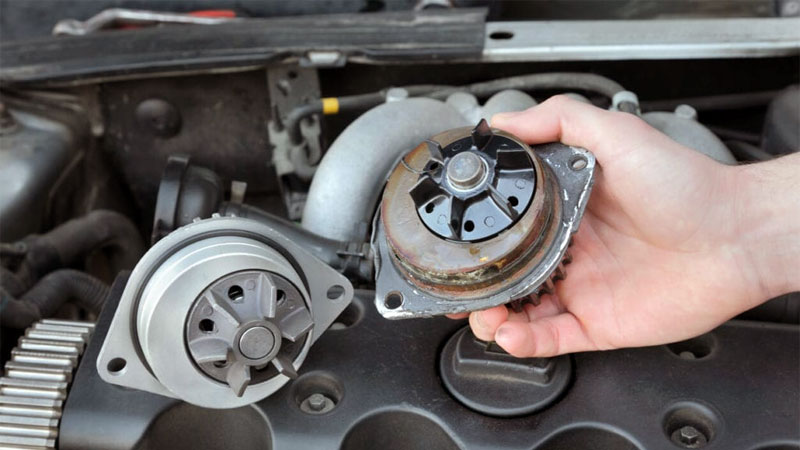
If the water pump fails, coolant won't be able to broadcast through the engine properly. The coolant in the radiator may be nice and cold, just the coolant surrounding the water jackets in the head and cake will exist extremely hot.
Without a pump, coolant will simply be able to circulate via the natural convection process, which is much too slow to remove backlog oestrus before the engine overheats.
4) Failed Thermostat
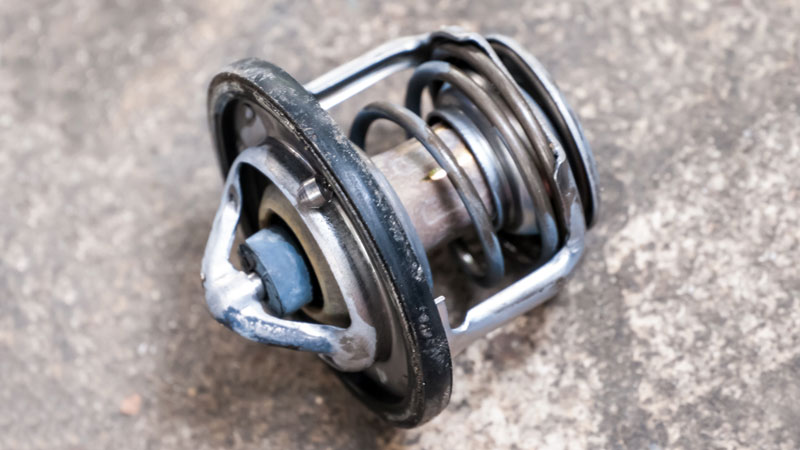
Combustion engines are nearly efficient when they are running at the operating temperature they were designed for.
An engine's normal operating temperature is still plenty hot enough to scald yous – typically around 190 to 210 degrees Fahrenheit (85 to 99 degrees Celsius). Running the engine below this temperature increases fuel consumption, emissions, and wear.
A thermostat blocks off coolant from the radiator until the coolant in the engine reaches the target temperature. Once the target temperature is reached, the thermostat opens to allow coolant at ambient temperature to enter the engine, cooling it until the thermostat is common cold enough to close. The cycle continues as the engine runs.
If the thermostat is stuck open up, your automobile will probably run pretty cold. This is because the coolant from the entire system is cycling through the radiator 100% of the time and rarely gets a chance to fully warm upwards.
If the thermostat is stuck airtight, your engine will overheat pretty hands. The hot coolant has nowhere to go to absurd off. In a pinch, some engines allow you to use the heater as a tiny radiator.
The effectiveness of this method depends on the size of the heater cadre and how the cooling organisation is routed.
5) Coolant Leak
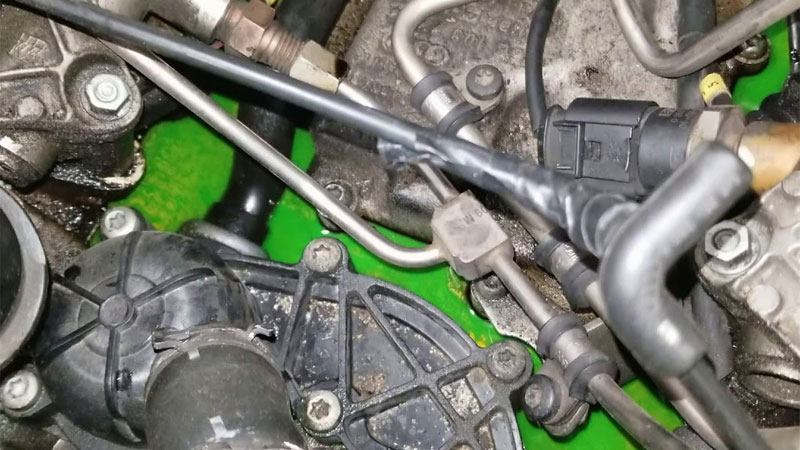
If too much coolant leaks out, somewhen you won't have enough to properly cool the engine. You lot can lose a decent amount of coolant before overheating, but it'southward a good thought to regularly check the overflow reservoir and radiator to make sure you're topped off.
If yous notice a coolant leak, it'due south a nifty idea to check your radiator cap. It's a cheap office with some serious repercussions if information technology fails. Keep in mind that non all coolant leaks are visible.
Warning: The radiator of a warm engine is under pressure. Do not open the radiator cap on a warm engine!
Cracked Cylinder Caput Symptoms
A minor crack in the cylinder head may go unnoticed for some fourth dimension, but the symptoms will be pretty obvious in astringent cases. Below are 5 common symptoms to watch out for in the outcome that this happens.
ane) Oil Leak

A cylinder head contains oil in it. If you have a croaky head, you tin can expect oil to leak out of it. Yous should notice the oil light on your dashboard turning on when this happens indicating a low oil force per unit area.
If y'all see this lite on, open your hood and endeavor to encounter if there's engine oil near the cylinder head.
Sometimes oil will leak internally. When this happens, y'all won't notice a puddle of oil, but may come across blue smoke out the frazzle.
2) Coolant Leak

Although a coolant leak can crusade a cracked head, it is also a symptom. If the cylinder caput is severely cracked, then yous'll probably have coolant leaking out of it in addition to oil.
This will cause your engine to overheat, which your car volition warn you about on your dashboard. Sometimes coolant leaks are internal. Internal leaks may leak into the oil passages or the combustion bedchamber.
Either way, cheque your coolant level and do not continue to drive when y'all have a visible coolant leak or detect the coolant level quickly dropping over time.
3) Poor Engine Performance
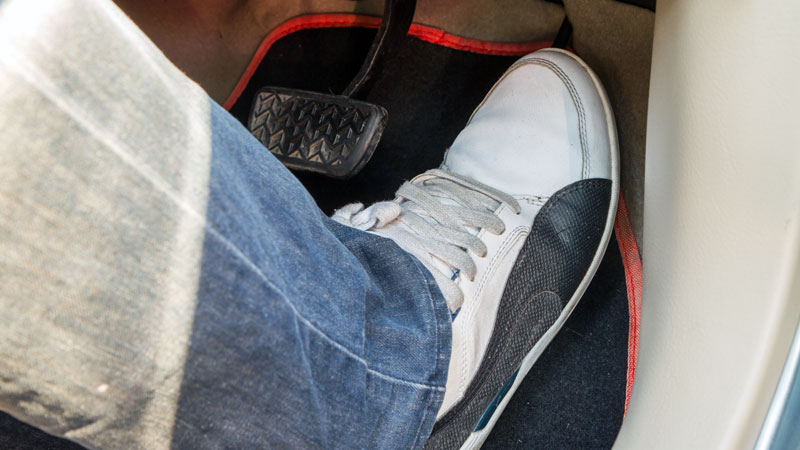
The outset symptom you might experience is a noticeable loss in engine ability. If the cylinder caput has a crack, that means compressed air is escaping from the combustion sleeping accommodation.
You will notice the engine running a lot slower or awkwardly once this happens.
iv) Smoke From Engine

Although this is rare, big cracks in the cylinder heads will allow coolant to leak into the combustion sleeping room and cause white smoke to come from the engine.
In addition, leaking oil can brand contact with hot engine components to produce this smoke. This is clearly a sign that a cracked cylinder head may be at mistake.
5) Engine Misfire
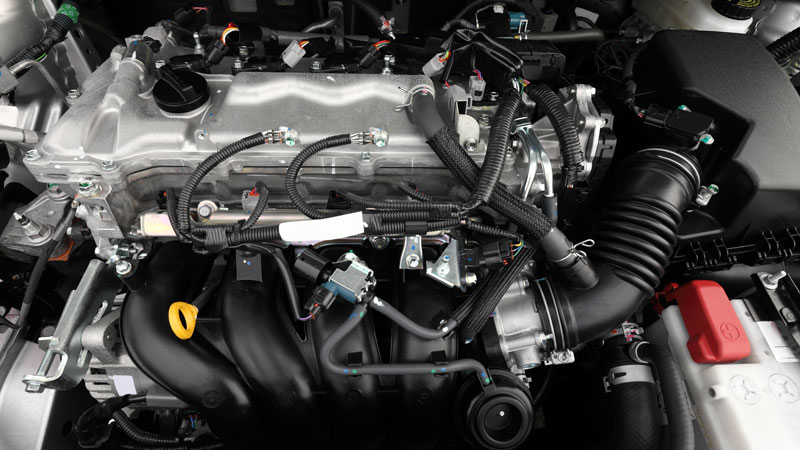
This relates to number iii. If the cracked cylinder head is astringent, then the mixture in the combustion chamber will crusade a misfire. This ways the mixture won't burn like it should.
Either that, or your engine will simply die as you lot're driving and you will take to repeatedly start information technology support.
Cracked Cylinder Caput Repair Cost
The cost of a cracked cylinder head repair chore will vary depending on the make and model of the vehicle that it's in. You can exist sure that it will price at to the lowest degree $500, which includes labor and parts costs.
If you were to replace the entire cylinder caput, it would only toll $200 to $300 on average for parts. With labor at most $90 to $100 per hour, this comes out to roughly $500 for the task. However, this is assuming the cylinder head is made of aluminum like they are in virtually cars these days.
If the cylinder heads are hard to access (as they are on Subarus, since they use a boxer engine layout), labor costs may exist significantly college.
If yous take an older vehicle or more than expensive vehicle, yous probably accept a cylinder caput fabricated of iron. Since iron is a more expensive fabric than aluminum, you might be looking at $500 simply for the parts.
The labor may likewise crave more hours for this repair task to exist done correctly. Therefore, you could be looking at $i,000 to repair a croaky cylinder head made of iron.
Source: https://oards.com/cracked-cylinder-head-symptoms-and-repair-cost/
Posted by: taymosted1971.blogspot.com


0 Response to "Does A Small Crack In A Subaru Head Need Repair?"
Post a Comment